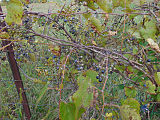Vitis riparia
This article needs additional citations for verification. (June 2011) |
| Vitis riparia | |
|---|---|

| |
| Scientific classification | |
| Kingdom: | Plantae |
| Clade: | Tracheophytes |
| Clade: | Angiosperms |
| Clade: | Eudicots |
| Clade: | Rosids |
| Order: | Vitales |
| Family: | Vitaceae |
| Genus: | Vitis |
| Species: | V. riparia
|
| Binomial name | |
| Vitis riparia | |
Vitis riparia Michx, with
Riverbank grape is a translation of the scientific name Vitis riparia; rīpārius means "of riverbanks" in Latin,[3] deriving from rīpa "riverbank".
Description
Mature vines have loose, fissured bark, and may attain several inches in diameter. Leaves are alternate, often with opposite tendrils or inflorescences, coarsely toothed, 5–25 cm (2.0–9.8 in) long and 5–20 cm (2.0–7.9 in) broad, sometimes with sparse hairs on the underside of veins.
V. riparia is functionally
Habitat
Vitis riparia has the largest geographical range of any of the North American Vitis species. It is present across nearly the entire eastern half of North America, from southern Quebec, to Piedmont, Alabama, and the Carolinas but absent of the coastal plains and the westerner parts of North America of the
In the wild, the vine thrives along exposed areas with good sun exposure and adequate soil moisture, such as riverbanks, forest clearings, fence lines and along road sides. The species has adapted to a variety of soil chemistries.


Cold hardiness and disease resistance
Some V. riparia vines have been known to withstand temperatures as low as −57 °C (−71 °F).
Uses
Perhaps the most significant agricultural usage of V. riparia is as grafted rootstock for Vitis vinifera. Important advantages of the use of V. riparia (and hybrids between it and other Vitis species) include resistance to phylloxera and adaptation to variant soil types.
Due to the extensive
While V. riparia shares many important characteristics with its cousin,
These grapes are sometimes used to make flavorful homemade
Gallery
- Vitis riparia
-
Botanical garden in Berlin, Germany.
-
Vitis riparia in Germany
-
Ontario, Canada
-
Vitis riparia leaf
-
Riparia gloire de Montpellier (rootstock)
References
- ^ "Vitis riparia". Germplasm Resources Information Network. Agricultural Research Service, United States Department of Agriculture. Retrieved 7 July 2015.
- ^ "Vitis riparia". County-level distribution map from the North American Plant Atlas (NAPA). Biota of North America Program (BONAP). 2014.
- ^ a b Burnham, Robyn J. (2014). "Vitis riparia". CLIMBERS: Censusing Lianas in Mesic Biomes of Eastern Regions. University of Michigan College of Literature, Sciences and the Arts.
- ^ Moore, Michael O. (2016). "Vitis riparia". In Flora of North America Editorial Committee (ed.). Flora of North America North of Mexico (FNA). Vol. 12. New York and Oxford: Oxford University Press – via eFloras.org, Missouri Botanical Garden, St. Louis, MO & Harvard University Herbaria, Cambridge, MA.
- ^ Rombough, Lon. The Grape Grower Chelsea Green Publishing, 2002. p. 218.
- OCLC 244766414.





